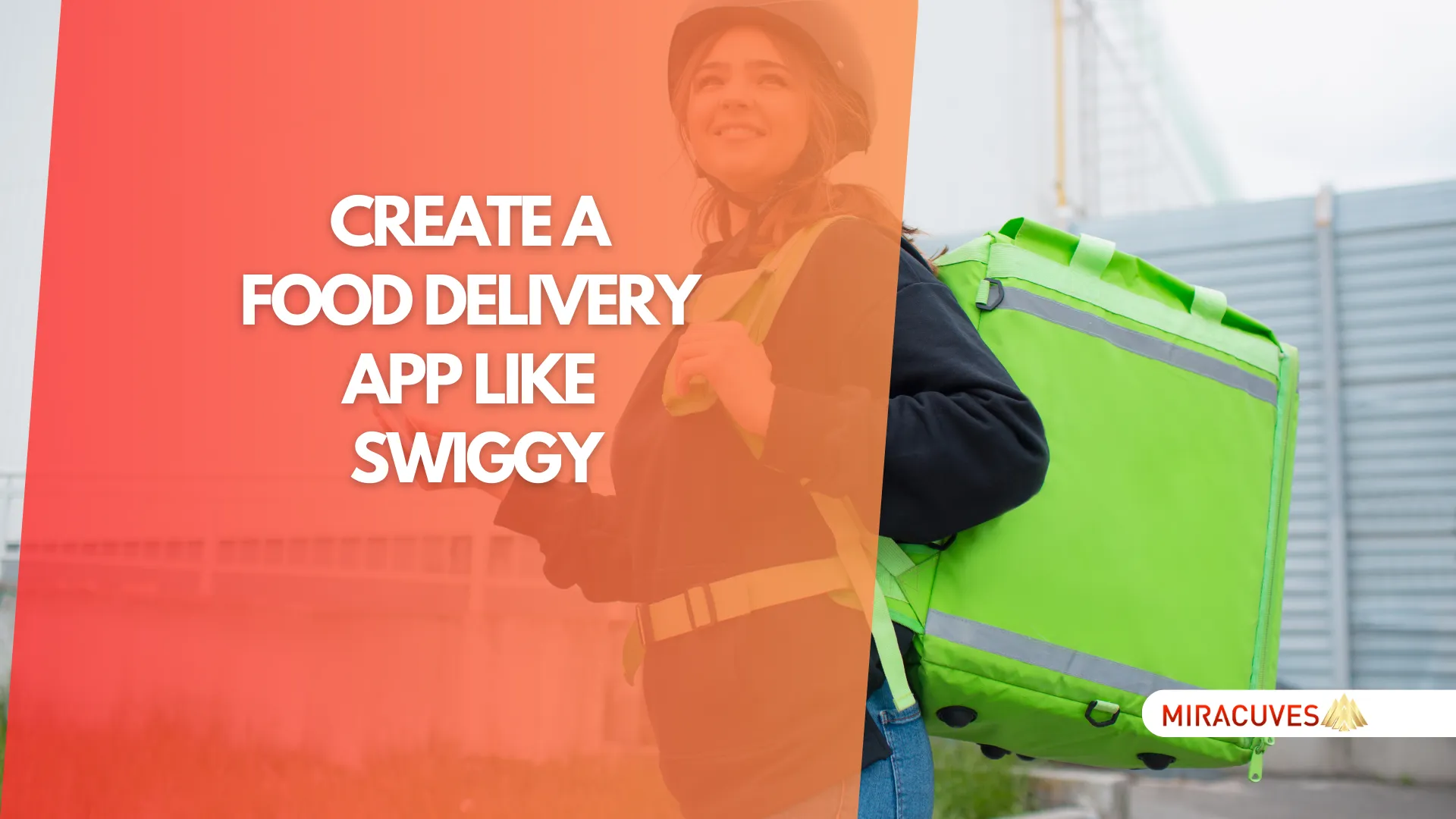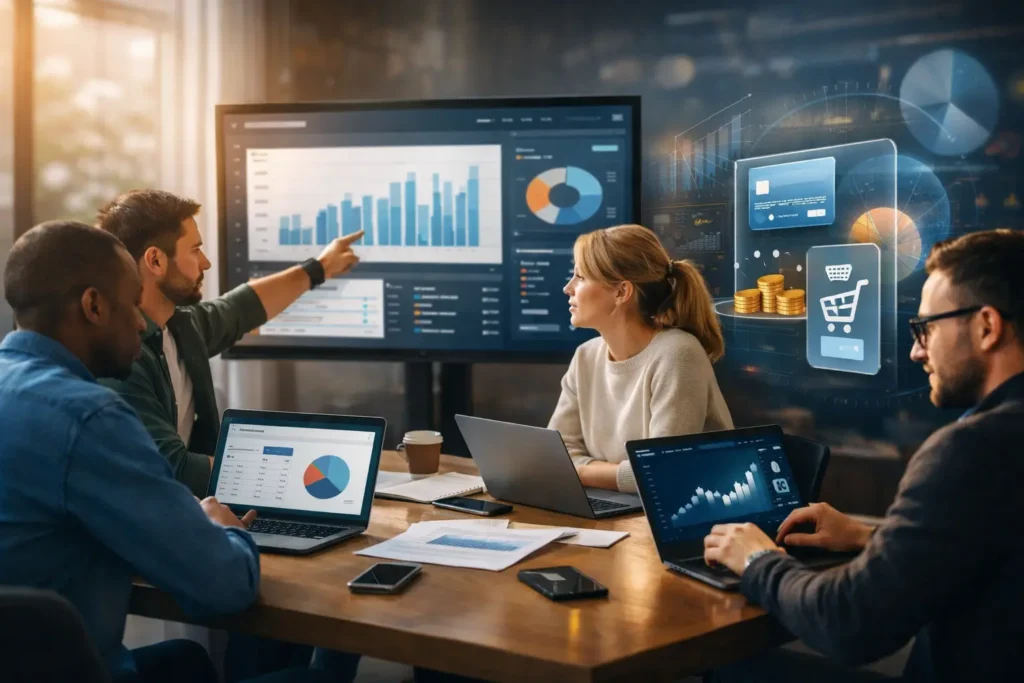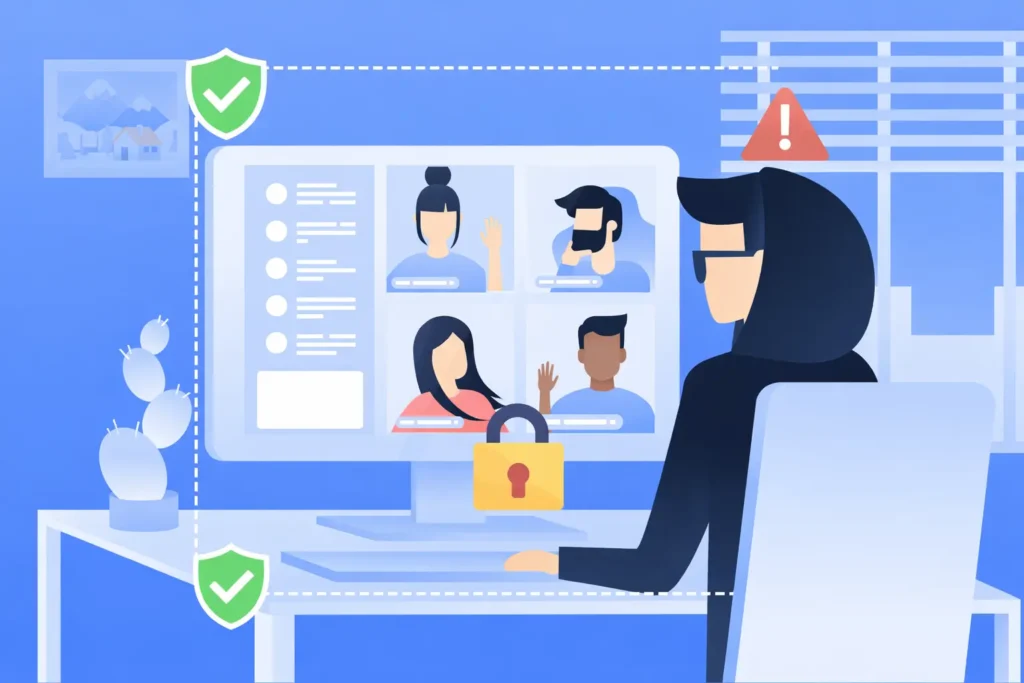In today’s fast-paced world, food delivery apps have revolutionized the way people access their favorite meals. Among the leaders in this space is Swiggy, a platform that has transformed food delivery into an on-demand service with the tap of a finger. With millions of users and thousands of partner restaurants, Swiggy’s success has inspired many entrepreneurs to create similar apps to capture a slice of this growing market.
Building an app like Swiggy offers immense business opportunities, especially with the global food delivery market projected to reach new heights in the coming years. If you’re considering launching your own food delivery app, you’re on the right path to tap into a high-demand, rapidly expanding industry. In this guide, we’ll walk you through the key features, development process, and costs associated with creating a food delivery app like Swiggy. And when it comes to bringing your vision to life, Miracuves Solutions is here to help you craft a seamless, high-performance app.
What is Swiggy and What Does It Do?
Swiggy is an on-demand food delivery service that connects customers with local restaurants, making it easy for people to order meals online and have them delivered to their doorstep. Launched in 2014, Swiggy has quickly become one of the largest food delivery platforms in India, serving millions of users across various cities. Its success lies in its simple, user-friendly interface, fast delivery, and a wide network of partner restaurants, ranging from local eateries to high-end dining.
Swiggy operates on a three-sided marketplace model, catering to customers, restaurants, and delivery partners. Customers can browse restaurants, check menus, and place orders. Restaurants receive orders and prepare the food, while delivery partners (drivers) handle the logistics of delivering the food to the customers. Swiggy also integrates advanced features like real-time order tracking, multiple payment options, and personalized recommendations, enhancing the user experience.
Why Build an App Like Swiggy?
The food delivery market is booming, and building an app like Swiggy offers immense potential for business growth. With the increasing demand for convenience, customers prefer ordering food online instead of cooking or dining out. Swiggy, with its efficient delivery model, has set a benchmark in this industry, offering a reliable service that meets modern consumer needs.
By building a similar app, you can tap into a thriving market, especially in urban areas where demand is highest. This market is projected to grow rapidly, driven by factors like busy lifestyles, the growing number of smartphone users, and the increasing trust in digital payments. Additionally, food delivery apps provide an opportunity to create revenue streams through various models, such as delivery commissions, restaurant partnerships, and in-app advertisements.
With the right strategy, your app could not only serve local needs but also scale to national or even global levels. Entering the food delivery industry now could position you at the forefront of this rapidly expanding market, allowing you to capture a significant share of the growing demand.
How to Differentiate Your App from Competitors
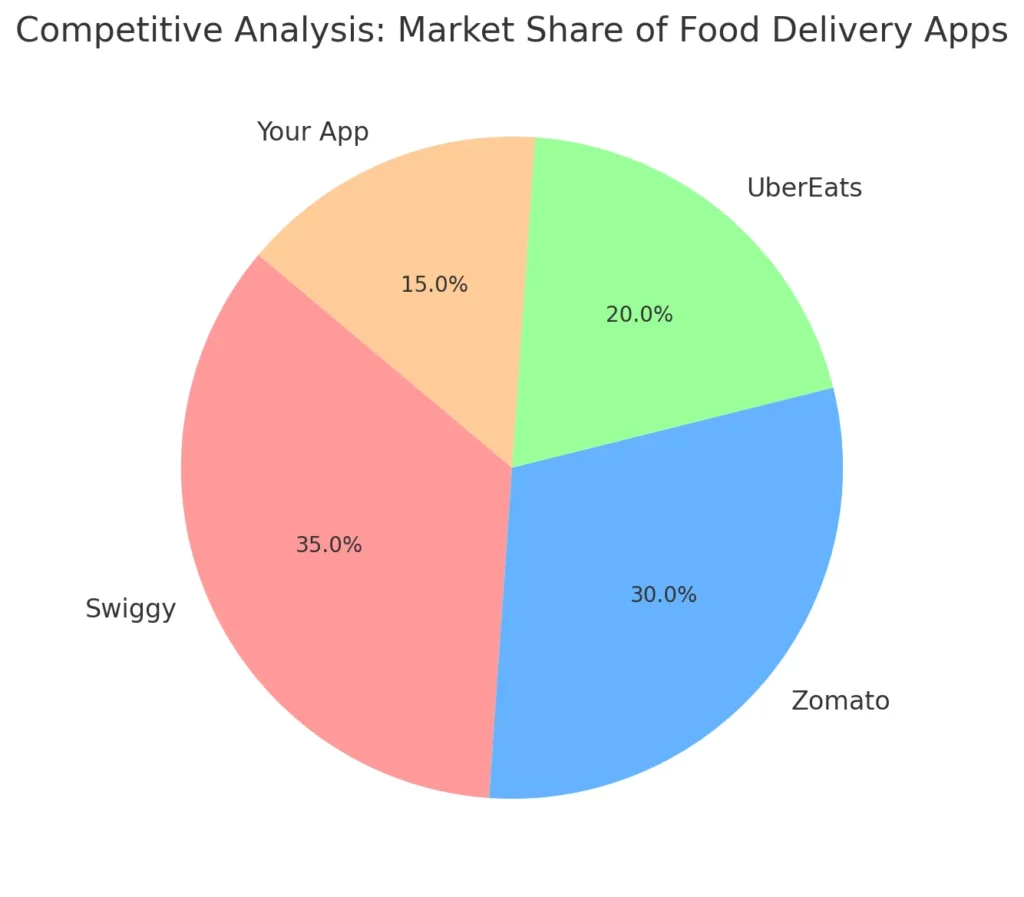
Building a food delivery app like Swiggy is just the beginning. To truly succeed, you need to stand out in an increasingly crowded marketplace. Differentiation is key to attracting and retaining users, and there are several ways to make your app unique.
- Niche Focus: One way to differentiate your app is by targeting a specific market segment. For example, you could focus on healthy food delivery, vegan restaurants, or home-cooked meals, catering to customers who prioritize specific dietary needs. This niche focus can help your app gain traction with a loyal user base.
- Superior User Experience: Prioritizing a seamless and intuitive user interface (UI) can set your app apart. Features like faster checkout, personalized recommendations, and easy reordering can significantly enhance user satisfaction. A clean design, fast load times, and minimal app crashes are essential for retaining customers.
- Innovative Features: Offering features that are not yet mainstream in the food delivery industry can give your app an edge. For instance, integrating AI-powered delivery route optimization, order customization (allowing users to request specific ingredients), or sustainability options (like opting for eco-friendly packaging) could help your app attract eco-conscious or tech-savvy consumers.
- Loyalty Programs: Implementing robust loyalty programs with rewards or discounts for repeat orders can also set you apart. Swiggy offers Super, a premium subscription service, but offering more unique perks like personalized gifts or VIP delivery could make your app even more appealing.
Market Size, Growth, and Business Model
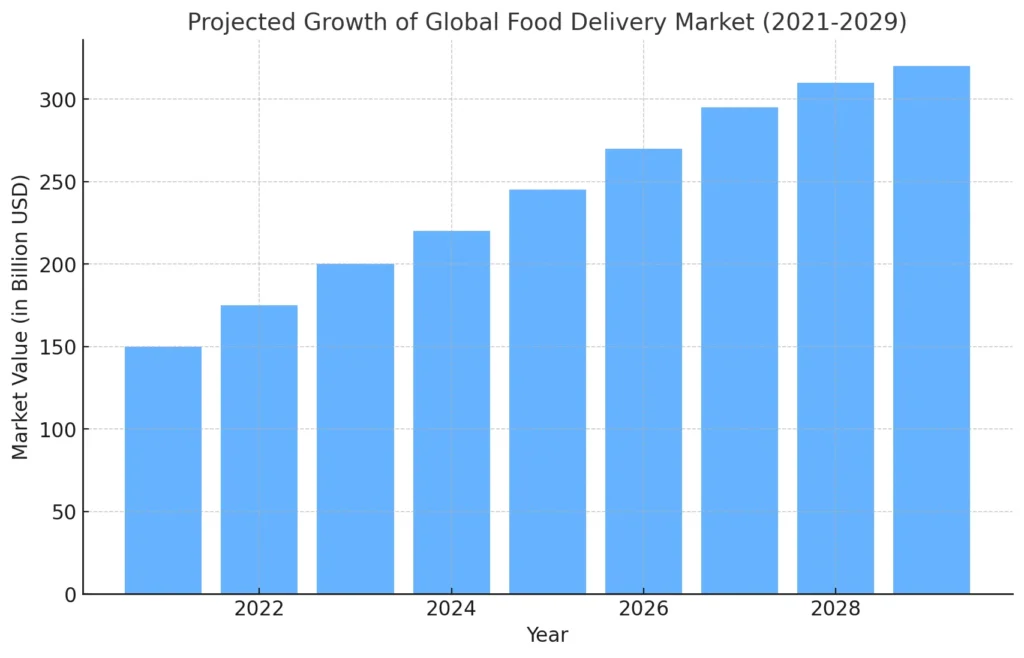
The food delivery market has experienced rapid growth in recent years, driven by changing consumer habits and the increasing convenience of ordering food online. According to recent data, the global food delivery market is projected to reach over $320 billion by 2029, growing at a compound annual growth rate (CAGR) of 10%. This growth is fueled by the rising demand for convenience, the expansion of internet access, and a growing base of mobile app users.
Countries in Asia, such as India and China, are experiencing the fastest growth in food delivery services, while Western markets continue to see steady expansion. As urbanization continues, more people are looking for quick and easy access to meals, which means the demand for apps like Swiggy will only increase.
In terms of business models, food delivery apps primarily generate revenue through:
- Commissions: Charging restaurants a percentage of each order.
- Delivery Fees: Adding a fee for each delivery.
- Subscription Models: Offering premium services with benefits like free delivery.
- In-App Advertising: Allowing restaurants to promote themselves on the platform.
These revenue streams, combined with the scalability of food delivery apps, offer significant opportunities for profitability as the market continues to grow.
Read More “Top 10 Ideas for Food Delivery Business Startups“
Key Features of a Swiggy-Like App
| User Type | Key Features |
|---|---|
| Customers | – User profiles and authentication |
| – Restaurant listings and menus | |
| – Real-time order tracking | |
| – Payment gateway integration | |
| – Push notifications for order status and offers | |
| – Ratings and reviews for restaurants and deliveries | |
| Restaurants | – Restaurant dashboard to manage orders |
| – Menu management and updates | |
| – Order notifications and real-time updates | |
| – Payment tracking and reporting | |
| Delivery Partners | – Delivery requests and real-time tracking |
| – GPS navigation and optimized routes | |
| – Earnings and payment tracking | |
| – Delivery history and reviews |
To build a successful food delivery app like Swiggy, it’s crucial to focus on the key features that drive both user engagement and operational efficiency. These features are designed to offer a seamless experience for all parties involved: customers, restaurants, and delivery partners.
- User Profiles and Authentication: Secure sign-up and login options, including social media integration, ensure users can easily create accounts and access the app.
- Restaurant Listings and Menus: Display restaurant options with detailed menus, ratings, and reviews. This helps customers choose where to order from based on their preferences.
- Real-Time Order Tracking: One of Swiggy’s standout features is the ability for users to track their orders in real-time, from preparation to delivery. This not only enhances customer satisfaction but also keeps them engaged with the app.
- Payment Gateway Integration: Offering multiple payment options, such as credit/debit cards, digital wallets, and even cash on delivery, ensures a frictionless checkout process.
- Push Notifications: Timely notifications about order status, delivery time, and offers keep users informed and encourage repeat orders.
- Ratings and Reviews: Allowing customers to rate restaurants and delivery service helps maintain quality standards and build trust within the platform.
- Admin Dashboard: A robust admin dashboard is essential for managing orders, payments, user data, and analytics.
Minimum Viable Product (MVP) Approach
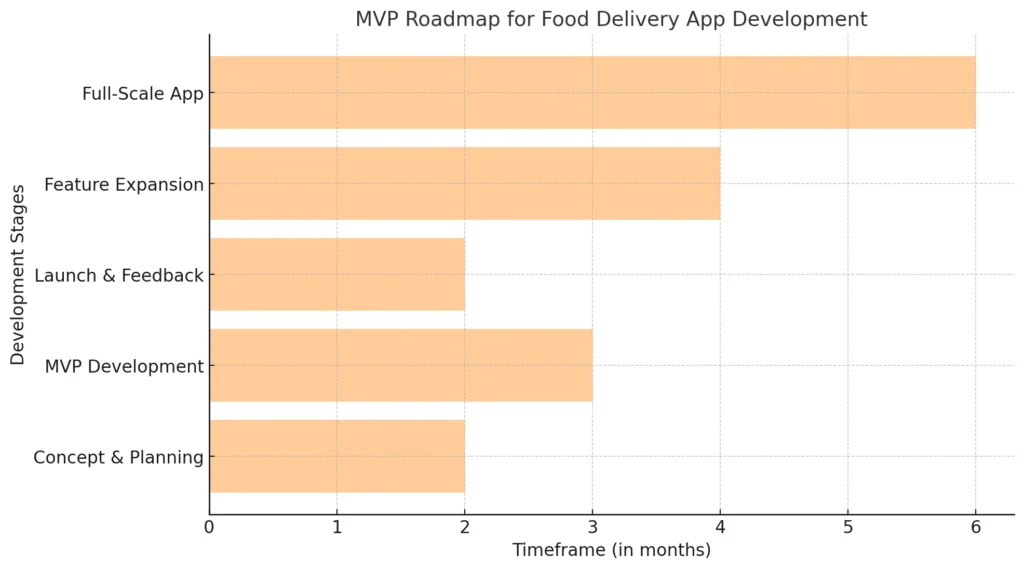
Building a full-scale food delivery app like Swiggy can be overwhelming in terms of cost and time, which is why starting with a Minimum Viable Product (MVP) is a smart strategy. An MVP focuses on launching with just the core features that provide immediate value to users, allowing you to enter the market quickly and gather essential feedback for future improvements.
The MVP approach not only reduces development time but also allows you to test your app’s functionality, user experience, and market fit without significant upfront investment. By launching with a simplified version, you can identify potential improvements and adjust your app according to real user behavior and needs.
Key Features for an MVP:
- User Registration and Authentication: Secure and simple login using social media accounts or email.
- Restaurant Listings and Search: Display local restaurants, their menus, and a search feature to allow users to find their preferred dishes.
- Basic Order Management: Allow users to place orders with real-time updates for restaurants and delivery partners.
- Payment Gateway: Integration with a secure payment system to allow transactions using multiple methods.
- Real-Time Order Tracking: Customers should be able to track the status of their orders from preparation to delivery.
Starting with these essential features, you can launch quickly, gather feedback, and begin scaling the app based on user preferences.
Read More “How to Develop a Food Delivery App Like Zomato: Features, Costs, and Timeline“
Technical Requirements
| Component | Option 1 | Option 2 | Why Choose? |
|---|---|---|---|
| Frontend | React Native | Flutter | React Native is great for faster development with a large community; Flutter offers high performance and beautiful UI. |
| Backend | Node.js | Python (Django) | Node.js provides scalability and speed; Python is known for its simplicity and robust framework. |
| Database | MySQL | MongoDB | MySQL is a structured, relational database; MongoDB is flexible and ideal for handling large datasets. |
| API Integration | Google Maps API | OpenStreetMap API | Google Maps offers superior accuracy for real-time tracking; OpenStreetMap is open-source and customizable. |
| Payment Gateway | Stripe | PayPal | Stripe is known for smooth integration and global support; PayPal is widely trusted by users. |
| Push Notifications | Firebase | OneSignal | Firebase is easy to integrate and widely used; OneSignal offers advanced segmentation options. |
Building a food delivery app like Swiggy requires a strong technical foundation to ensure smooth functionality for users, restaurants, and delivery partners. The technology stack you choose will significantly impact the performance, scalability, and future growth of your app. Here’s an overview of the technical requirements:
- Frontend Development: The user interface (UI) of the app should be intuitive and responsive. Commonly used technologies for frontend development include React Native and Flutter for cross-platform mobile apps. These frameworks allow you to build apps for both iOS and Android using a single codebase, reducing development time and cost.
- Backend Development: The backend is the core engine of your app, handling data, user authentication, and communication between the customer, restaurant, and delivery partner. Technologies like Node.js or Python (Django) are popular choices for their scalability and performance. A RESTful API will connect the backend with the frontend and handle requests in real-time.
- Databases: To store user data, order history, and restaurant information, reliable databases such as MySQL, MongoDB, or PostgreSQL are essential. These databases are known for their speed, security, and scalability, ensuring your app can handle increasing traffic as it grows.
- APIs: Integrating third-party services is crucial for a smooth user experience. Some important APIs include:
- Google Maps API for real-time tracking and location services.
- Payment gateway APIs (such as Stripe or PayPal) for secure transactions.
- Push notification services like Firebase to keep users updated on their order status.
Choosing the right technical stack ensures that your app is robust, scalable, and ready to adapt as your user base grows.
Design and User Interface (UI/UX)
In a food delivery app like Swiggy, a smooth and attractive user interface (UI) plays a critical role in keeping users engaged. From browsing restaurants to tracking orders, every interaction should feel intuitive and seamless. A well-designed user experience (UX) encourages customers to return to your app, making it one of the key factors in app success.
- Intuitive Navigation: Simplicity is key. Ensure that users can easily navigate through the app, whether they’re searching for a restaurant, customizing an order, or completing a payment. Clear icons, a well-organized menu, and minimalistic design elements improve usability.
- Engaging Visuals: The design should reflect your brand’s personality. Use high-quality images, vibrant colors, and appealing layouts to make the app visually engaging. Make sure that the design is consistent across platforms, ensuring a uniform experience for both iOS and Android users.
- Responsive Design: A responsive app design ensures that the layout adjusts well on all screen sizes. Whether users are on a smartphone or tablet, the experience should remain smooth and easy to navigate.
- Fast Loading Time: Performance is crucial to UI/UX design. An app that loads quickly will keep users from getting frustrated. Compressing images and optimizing code can improve loading speeds significantly.
- User Feedback Integration: Including features like order tracking and notifications allows users to stay informed. Adding interactive elements like ratings and reviews gives users a sense of involvement and control over their experience.
By focusing on a well-crafted UI/UX, you’ll not only make your app more appealing but also increase user retention and satisfaction.
Development Process
Building a food delivery app like Swiggy requires a structured and efficient development process to ensure all features work seamlessly together. The development journey involves multiple stages, each critical for creating a reliable, scalable app that users will love.
- Idea Validation and Market Research: Before diving into development, it’s crucial to validate your app idea through thorough market research. Understand your target audience, analyze competitors, and identify any gaps in the market that your app can fill. This step helps refine your app’s core concept and ensures it meets actual user needs.
- Wireframing and Prototyping: Once the idea is validated, the next step is to create wireframes and prototypes. Wireframes are rough layouts of your app, showing how each screen will be structured and how users will navigate through the app. Prototypes bring wireframes to life, allowing you to test the user flow and gather early feedback.
- Frontend and Backend Development: In this stage, your app comes to life. The frontend development focuses on building the app interface that users interact with, ensuring it is visually appealing and responsive. The backend development handles the server, database, and APIs that power the app, ensuring data is processed and delivered smoothly. A strong backend architecture is essential to handle high user traffic and real-time order updates.
- Testing: Rigorous testing is vital to ensure your app works flawlessly across all devices and scenarios. Testing includes:
- Unit Testing: Checking individual components of the app.
- User Acceptance Testing (UAT): Ensuring the app meets user expectations.
- Stress Testing: Ensuring the app performs well under high traffic. Fixing bugs during this stage helps ensure a smooth launch without any technical hiccups.
- Deployment: Once testing is complete, your app is ready for deployment. Submitting the app to platforms like the Apple App Store and Google Play Store is the final step before launch. At this stage, proper App Store Optimization (ASO) is key to making sure your app is visible and attracts downloads.
Each stage in the development process builds on the previous one, creating a solid foundation for a successful app that can evolve and scale as your business grows.
Cost Estimation and Timeframe
| Feature/Component | Cost Range | Development Timeframe |
|---|---|---|
| Basic Features (MVP) | $30,000 – $50,000 | 3 – 6 months |
| – User registration | ||
| – Restaurant listings | ||
| – Order management | ||
| – Payment gateway | ||
| Advanced Features | $70,000 – $150,000 | 6 – 12 months |
| – Real-time tracking | ||
| – Push notifications | ||
| – AI-powered recommendations | ||
| – Loyalty programs | ||
| UI/UX Design | $5,000 – $20,000 | 1 – 2 months |
| Development Team Location | ||
| – North America | $100 – $200 per hour | |
| – Europe | $50 – $150 per hour | |
| – Asia (e.g., India) | $20 – $50 per hour | |
| Ongoing Maintenance | 15-20% of development cost per year | Ongoing |
Developing a food delivery app like Swiggy requires careful financial planning, as the cost depends on various factors, including the complexity of features, the technology stack, and the geographical location of the development team. Understanding these elements will help you create a realistic budget and timeline for your project.
- App Features and Complexity: The more features your app includes, the higher the development cost. A basic MVP with essential features like user registration, restaurant listings, and payment integration may cost less, while advanced features such as real-time order tracking, AI-powered recommendations, and loyalty programs will increase the budget. Typically, the development of a food delivery app ranges from $30,000 to $150,000, depending on the scope.
- Design Costs: UI/UX design is another significant factor. A user-friendly interface with appealing visuals can cost around $5,000 to $20,000, depending on the level of customization and detail.
- Development Team Location: The cost of hiring developers varies across different regions. For instance:
- North America: $100 – $200 per hour
- Europe: $50 – $150 per hour
- Asia (e.g., India): $20 – $50 per hour
- Development Timeframe: The timeline for developing a food delivery app also depends on its complexity. For a basic MVP, you’re looking at around 3 to 6 months. For a fully-featured app with advanced functionalities, the development timeframe may extend to 8 to 12 months.
- Ongoing Maintenance: After launching the app, ongoing maintenance and updates will be necessary to keep it running smoothly and improve features based on user feedback. This typically costs around 15-20% of the total development cost per year.
Mention Miracuves Solutions: At Miracuves Solutions, we offer transparent pricing tailored to your needs, helping you manage development costs efficiently while ensuring high-quality results.
Looking to launch a food delivery app like Swiggy?
Our expert team can help you develop a platform that
combines seamless food ordering, real-time delivery tracking, and a user-friendly interface.
Monetization Strategies
When building a food delivery app like Swiggy, a solid monetization plan is essential to ensure profitability. There are several strategies you can implement to generate revenue from your app. The right approach depends on your business model and target market, but a combination of these methods often yields the best results.
- Commission on Orders: This is one of the most common ways food delivery apps make money. For every order placed through your platform, you can charge restaurants a commission fee. The percentage typically ranges from 15% to 30% of the order value, depending on the partnership agreement.
- Delivery Fees: Charging customers a delivery fee is another reliable revenue stream. These fees can vary based on the distance, order size, or peak times. Some apps also offer free delivery on minimum order values, encouraging larger orders.
- Subscription Services: Offering a subscription service, like Swiggy’s Super membership, provides users with benefits such as free delivery, exclusive discounts, and faster service. This creates a steady stream of recurring revenue while enhancing customer loyalty.
- In-App Advertising: Restaurants can pay to promote their listings within the app. Featured placements or banner ads help restaurants gain more visibility, particularly during peak times, allowing you to charge premium rates for ad space.
- Surge Pricing: During high-demand periods, like weekends or festivals, you can implement surge pricing, where delivery fees increase due to higher demand. This method helps manage peak-time traffic and encourages more delivery partners to accept orders.
- Partnerships and Sponsorships: Partnering with restaurants, beverage companies, or other food-related brands can provide additional revenue through sponsorship deals, co-branded promotions, or exclusive offers.
- Premium Listings for Restaurants: Some food delivery apps offer restaurants the option to pay for premium listing positions on the app, giving them higher visibility, which translates into more orders.
By diversifying your revenue streams with these monetization strategies, your app can build a sustainable and profitable business model.
Launching and Marketing the App
Once your food delivery app is developed and ready, the next critical step is launching it successfully and creating an effective marketing strategy to attract users. A well-executed launch can set the stage for long-term success by generating buzz, securing downloads, and fostering engagement from day one. Here are the key steps for a successful app launch and marketing campaign:
- Pre-Launch Preparation: Before launching, it’s essential to build anticipation. Start by creating a landing page for your app, where users can sign up for early access or updates. Leverage social media platforms to generate interest, post sneak peeks, and share behind-the-scenes content. Partnering with influencers or food bloggers can also help increase visibility before the app officially goes live.
- App Store Optimization (ASO): To ensure that your app ranks high in app store search results, implement App Store Optimization (ASO) strategies. This includes using targeted keywords in the app title, description, and metadata. High-quality app screenshots and a compelling video preview can also improve your app’s chances of standing out. Focus on both the Apple App Store and Google Play Store to reach a broad audience.
- Digital Marketing Campaigns: Once your app is live, launch digital marketing campaigns across multiple channels. Google Ads, Facebook Ads, and Instagram promotions are effective ways to reach your target audience. You can run paid campaigns that highlight key features or offer promotions such as discounts on first-time orders to encourage downloads.
- Referral Programs: Word-of-mouth marketing is incredibly powerful. Create a referral program where users can invite friends to download the app and receive rewards like free deliveries or discounts. This encourages existing users to promote your app while giving new users a reason to try it out.
- Partnerships with Local Restaurants: A great way to kickstart your app’s growth is by forming partnerships with popular local restaurants. Offer exclusive deals or discounts for restaurants that are onboard during the launch period. Highlighting these partnerships in your marketing campaigns can also attract more customers.
- Push Notifications: After users have downloaded the app, push notifications are a great way to keep them engaged. Send notifications about special offers, new restaurant listings, or personalized recommendations based on previous orders. However, be mindful not to overwhelm users with too many notifications, as this could lead to app uninstalls.
- Tracking and Analytics: After launch, it’s crucial to track user behavior through analytics tools. Monitor app downloads, user engagement, and retention rates to identify which marketing strategies are working and where improvements can be made. Analyzing this data allows you to refine your marketing campaigns and improve the overall user experience.
By combining these strategies, you can create a strong launch and marketing campaign that ensures your app gains traction and stands out in the competitive food delivery market.
Legal and Regulatory Considerations
When developing and launching a food delivery app like Swiggy, it’s essential to ensure that you comply with all legal and regulatory requirements. This not only protects your business from legal issues but also builds trust with your users, restaurants, and delivery partners. Here are the key legal and regulatory aspects you should consider:
- Data Privacy and Protection: One of the most critical areas for any app is data privacy. You will collect sensitive information such as user addresses, payment details, and order history. Make sure your app complies with global data protection regulations such as General Data Protection Regulation (GDPR) for European users or California Consumer Privacy Act (CCPA) in the U.S. Implement robust data encryption, secure servers, and clear privacy policies to protect user data.
- Terms and Conditions & Privacy Policy: Drafting clear Terms and Conditions and a Privacy Policy is vital. These documents should outline the rules users must follow while using the app, how their data will be handled, and what the business’s responsibilities are. Transparency in these legal documents builds trust with users and helps manage any legal risks.
- Food Safety and Health Regulations: Depending on your region, there may be specific food safety and health regulations you need to follow. For example, ensuring that partner restaurants comply with local health standards is crucial for your app’s reputation. You may need to verify licenses, certifications, or health inspection records for the restaurants you onboard.
- Delivery Partner Regulations: If your app hires delivery partners, ensure that your business complies with labor laws. Depending on the country or region, you may need to classify your delivery partners as employees or independent contractors, which affects taxes, insurance, and benefits. Make sure you adhere to regulations regarding wages, working conditions, and any insurance requirements for delivery personnel.
- Payment Compliance: Payment gateway integration must adhere to the legal requirements of each country where your app operates. Ensure that your app complies with Payment Card Industry Data Security Standard (PCI DSS) to securely process card transactions. Also, look out for local payment regulations and any restrictions on payment methods.
- Advertising Laws: If your app offers in-app advertisements or features promoted restaurants, make sure these advertisements comply with local advertising laws. False advertising or misleading promotions can lead to legal consequences, so ensure all content is accurate and transparent.
- Intellectual Property Protection: Protect your app’s intellectual property by filing for patents, trademarks, or copyrights where necessary. This includes protecting the app’s brand name, logo, and any unique features that set it apart from competitors.
By ensuring compliance with these legal and regulatory requirements, you not only safeguard your business but also foster trust among your users and partners.
Future Growth
As the food delivery industry continues to expand, the potential for future growth is immense. To ensure your app remains competitive and adaptable in the long run, planning for scalability and continuous improvement is key. Here are some strategies to keep your food delivery app on a path of sustained growth:
- Scaling the App: As your user base grows, it’s crucial to scale your app’s infrastructure to handle increased traffic and demand. This includes optimizing server capacity, improving backend performance, and ensuring the app functions smoothly even during peak hours. Investing in cloud-based solutions, like AWS or Google Cloud, can help manage this growth efficiently without compromising performance.
- Expanding to New Markets: Once your app has established a strong presence in its initial market, consider expanding to new cities or countries. Research the market demands, regulatory requirements, and local competition in these areas. By adapting your app to suit regional needs and preferences, you can increase your reach and tap into new customer bases.
- Adding New Features: Continuous innovation is crucial to keeping users engaged. Regularly introduce new features based on user feedback and market trends. For example, integrating voice search, offering customizable meal plans, or launching a rewards system can enhance user experience and increase retention rates. Stay ahead of the competition by adopting the latest technologies, such as AI-powered recommendations or machine learning for delivery route optimization.
- Building Strategic Partnerships: Forming partnerships with major brands, local grocery stores, or specialty restaurants can provide new opportunities for growth. You can also collaborate with non-food service providers, such as pharmacies or retail stores, to diversify your delivery offerings and attract a broader audience.
- Marketing and User Retention: Investing in long-term marketing strategies is essential for maintaining growth. Continue using targeted social media campaigns, personalized push notifications, and email marketing to retain existing customers while attracting new ones. Loyalty programs, exclusive deals, and referral incentives can help you keep users coming back.
- Sustainability Initiatives: As consumers become more environmentally conscious, integrating sustainability practices into your app can provide a competitive edge. Consider offering eco-friendly packaging options, promoting carbon-neutral deliveries, or partnering with local farms for organic meal deliveries. These initiatives resonate with environmentally conscious users and can create positive brand associations.
By focusing on scalability, user engagement, and market expansion, your food delivery app can continue to thrive in a highly competitive industry. Keeping an eye on technological advancements and customer needs will ensure your app evolves with the market.
Why Trust Miracuves Solutions for Your Next Project?
| Reasons to Trust Miracuves Solutions | Details |
|---|---|
| Proven Expertise | Years of experience in app development across industries, including food delivery. |
| Tailored Solutions | Custom app development solutions tailored to your business needs and budget. |
| Full-Cycle Development Support | End-to-end support from concept, design, development, to post-launch services. |
| Focus on Scalability and Growth | Apps built for scalability to handle future growth and user demand. |
| Commitment to Quality | High standards for UI/UX design, robust functionality, and thorough testing. |
| Cost-Effective Development | Transparent pricing, no hidden fees, with a focus on maximizing ROI. |
Choosing the right development partner is crucial when building a successful app like Swiggy. With Miracuves Solutions, you gain access to a team of experts who understand the intricacies of the food delivery industry and can bring your vision to life with precision and care. Here’s why Miracuves Solutions stands out as the ideal choice for your next project:
- Proven Expertise: With years of experience in app development, Miracuves Solutions has a proven track record of delivering high-quality mobile and web applications. Our team has worked on numerous successful projects across multiple industries, including food delivery, e-commerce, and on-demand services.
- Tailored Solutions: We know that every business is unique, and we specialize in providing custom solutions that align with your specific needs. Whether you’re looking to build an MVP or a fully-featured app, we’ll work with you to develop a tailored approach that fits your budget and goals.
- Full-Cycle Development Support: From concept to launch and beyond, Miracuves Solutions offers end-to-end development services. We handle everything—from ideation, UI/UX design, and backend development to testing, deployment, and ongoing support. This ensures that your app is built to perfection at every stage of development.
- Focus on Scalability and Future Growth: At Miracuves Solutions, we don’t just develop apps—we build platforms designed for long-term success. Our team ensures your app is scalable, so it can handle growing user bases and increasing traffic without compromising performance. We also offer ongoing maintenance and feature expansion to keep your app competitive in the ever-evolving market.
- Commitment to Quality: Quality is at the heart of everything we do. We use the latest technologies and industry best practices to create apps that are not only functional but also visually appealing and user-friendly. Rigorous testing ensures your app is bug-free and ready to deliver a seamless experience from day one.
- Cost-Effective Development: We understand the importance of staying within budget, especially for startups and small businesses. Miracuves Solutions provides transparent pricing with no hidden fees. Our focus is on delivering high-quality solutions at a cost that fits your financial plan, allowing you to maximize your return on investment.
When you partner with Miracuves Solutions, you’re not just getting a development team—you’re getting a dedicated technology partner committed to your success. Let us help you bring your food delivery app idea to life, scale it to new heights, and achieve lasting success in the competitive app market.
Conclusion
Creating a food delivery app like Swiggy offers an incredible opportunity to tap into the booming on-demand services market. With the right features, a seamless user experience, and a solid business model, you can build an app that caters to modern consumer needs and stands out in a competitive landscape. From the initial concept and MVP development to launching and scaling your app, each step requires careful planning and execution.
By leveraging the right technology stack, focusing on user-centric design, and staying on top of legal and regulatory requirements, your app can thrive in today’s fast-evolving digital ecosystem. Furthermore, investing in long-term growth strategies such as partnerships, expanding to new markets, and integrating innovative features will ensure your app remains relevant and profitable for years to come.
When it comes to bringing your food delivery app idea to life, Miracuves Solution is the partner you can trust to deliver exceptional results. With their expertise in app development, full-cycle support, and commitment to quality, your app is set for success.
Want to see how a food delivery app works?
Explore how our platform integrates features like real-time delivery tracking, restaurant partnerships, and smooth order management—just like Swiggy.
FAQs
How long does it take to build a food delivery app like Swiggy?
Building a basic MVP can take around 3 to 6 months, while a fully-featured app may take 8 to 12 months, depending on the complexity and features.
What is the cost of developing an app like Swiggy?
The cost ranges from $30,000 to $150,000 depending on the features, design, and the location of the development team.
How do food delivery apps make money?
Food delivery apps generate revenue through commission fees from restaurants, delivery charges, subscription models, in-app advertising, and surge pricing during peak demand.
What are the essential features of a food delivery app?
Core features include user registration, restaurant listings, order management, payment gateway integration, real-time order tracking, and push notifications.
How do I ensure my food delivery app complies with legal regulations?
Ensure your app complies with data privacy laws (GDPR, CCPA), food safety regulations, and labor laws for delivery partners. Implement secure payment gateways in line with PCI-DSS standards.
Check out the top-rated food delivery solutions offered by Miracuves – built for performance and scale:
- Swiggy Like Services – Effortless food delivery experiences with real-time tracking, easy ordering, and broad restaurant choices inspired by Swiggy’s convenience and speed.
- Zomato Clone Alternative – A powerful all-in-one platform for discovering top restaurants, ordering food online, reading reviews, and exploring cuisines.



